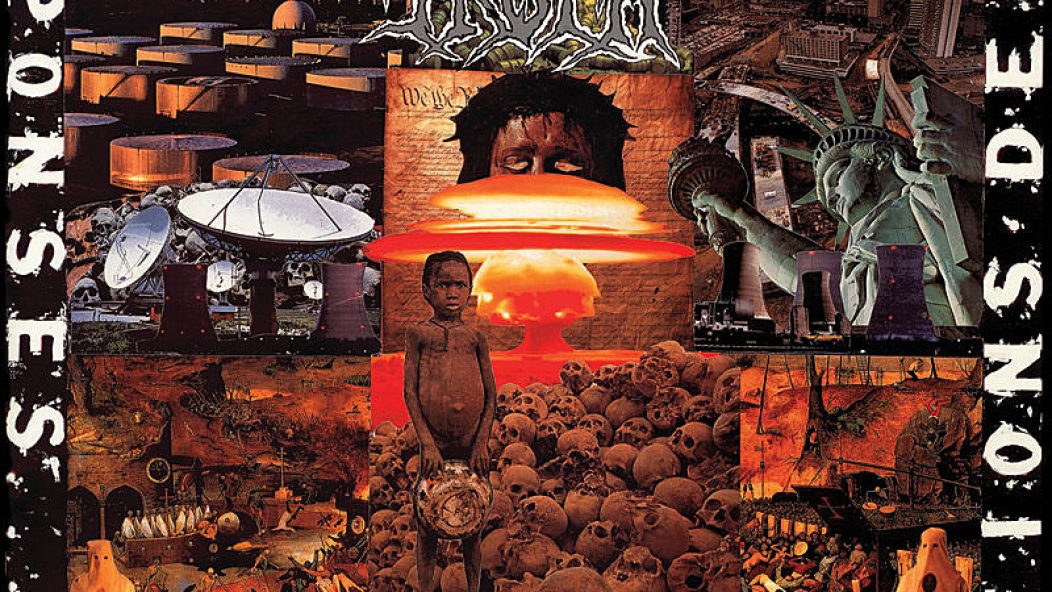
Gateways to Gaming #2: The Brutal Truth About Doom 64
Gateways to Gaming is a column where The Necrosexual discusses classic video games and albums that shaped his musical world and twisted his mind.
…
Welcome to hell!
This chapter of Gateways To Gaming examines the caustic combination of Doom 64 with Brutal Truth‘s Extreme Conditions Demand Extreme Responses, both cult classics in their own right. Brutal Truth’s 1993 debut is the quintessential deathgrind album, a blurring of hyperspeed with skull-rattling savagery. It’s the perfect record to pair with a descent into hell via Doom 64—the best Doom game of the nineties, as well as the most under appreciated game of the entire series.
“Backwards, Forward / Meaningless answers / Time goes on…”
So goes a passage from “Time” off Extreme Conditions Demand Extreme Responses. And indeed, as time slogs ahead, Doom remains the same. Go to hell, rip and tear, repeat. It’s an ingeniously simple recipe. Three decades since its primitive origins in 1993, Doom offers all the familiar delights for one to “raze hell.” Super shotgun? Check? Floating cycloptic meatballs with sharp teeth? Got it. No real storyline aside from killing everything that moves, and maybe grabbing a blue key along the way? Of course. Each reiteration is boosted with incremental improvements to its graphics and gameplay, but overall, Doom is the Groundhog’s Day of first-person shooters.
…
…
Doom 64 arrived on the Nintendo 64 in 1997, a competitive year for game titles. Nintendo’s 64-bit upgrade ushered in a new golden age with its innovative system. How innovative? Remember, the N64 introduced many now-commonplace features, such as controllers with joysticks for the thumbs. These controllers were also the first to vibrate, thanks to a slyly-named “Rumble Pak,” which added a tactile layer to the experience for the first time. N64 also accommodated up to four players at once, which doubled the possibilities for marathon sessions with your buddies.
The original Doom chainsawed a path for heavy hitters like Goldeneye 64 and Turok: Dinosaur Hunter to follow, but this more sophisticated generation of shooters overshadowed Doom 64. Unlike its peers, Doom 64 lacked the functionality to aim one’s gun up and down the Y axis. Nor did it have one of the greatest self-contained multiplayer modes ever made, like in Goldeneye 64. (No dial-up connection needed.) However, Doom 64‘s graphics have aged far better than Doom and Doom II, whose blockish pixels look like a sand art mosaic as the player moves, and it’s more challenging than its predecessors.
Doom 64 continues the lineage as one of the most metal-looking video games ever made. Its 28 levels are filled with pentagrams, heads on poles, giant skull motifs carved into the walls – the stuff many album covers from the nineties are made of. The floors are often coated with hot lava or neon green sludge, waiting to kill you if you make one misstep, because there is no jump button.
A song like Brutal Truth’s “Walking Corpse” reveals the essence of Doom 64 in its gory glory. Blast beats unleashed with the relentless speed of a chaingun as it liquifies a pack of minotaurs into a pile of quivering guts; demonic vocals that shift from low rumblings to skin-charred shrieks: Extreme Conditions Demand Extreme Responses balances the raw power of a buzzsaw with the deadly precision of a plasma rifle, to put it in Doom terms.
…
…
One key “God Player” in Brutal Truth is their bassist and founding member Dan Lilker, who by 1993, had blazed through the eighties with several groundbreaking albums in his portfolio. Each new band grasped farther at the reaches of extremity. He played in the first class of thrash metal on Anthrax’s debut album Fistful Of Metal. Lilker then enlisted in the Stormtroopers Of Death with his former Anthrax mates Charlie Benante and Scott Ian in 1985. Their brazenly politically incorrect one-off Speak English Or Die remains a ferocious slamdancing hybrid of hardcore punk and thrash, with bursts of proto-grindcore in its blast beats and short song lengths. Lilker continued to push the speed limit in Nuclear Assault. Their run included three thrashing classics in Game Over (1986), Survive (1988), and Handle With Care (1989). Lilker departed from Nuclear Assault soon after their underwhelming Out Of Order album, but not before recording a four-song demo called Birth Of Ignorance in 1990, with a new band called Brutal Truth. (Three songs from this demo would later appear on Extreme Conditions Demand Extreme Responses.)
Brutal Truth’s frenzied debut album dropped in 1993, the same year the inaugural Doom ratcheted onto computer screens. This blockbuster year for death metal saw bands like Morbid Angel and Death on MTV, as they were featured on Headbangers Ball and roasted by Beavis and Butthead. In Europe, the second wave of Norweigan black metal had emerged from its frosty underground with a rabid fury.
Brutal Truth differentiated from their peers by coating their debut album with a street-hardened grime. Rather than shock value lyrics about gore and violence, they focused on the crushing heaviness of real world issues. Tracks like “Anti-Homophobe”, “Monetary Gain,” and “Stench Of Profit” tackle themes of prejudice, consumer culture, and greed. Vocalist Kevin Sharp bellows and howls through the record with an animalistic fury, beneath which lies a palpable sense of cynicism.
While their grindcore colleagues in Carcass and Napalm Death shifted into slower, more melodic territory, Brutal Truth kept their foot on the ignition. The speediest songs by Morbid Angel and Suffocation still seem to drag ass compared to Scott Lewis’ blast beats, which practically break the sound barrier. Cryptopsy drummer Flo Mournier cites Extreme Conditions Demand Extreme Responses as a major inspiration for his band’s speeds, specifically, with Lewis’ use of china cymbal blast beats. (Decibel Magazine, October 25 2018)
…
https://www.youtube.com/watch?v=gDMTZy0d7f8
…
For the task of pulverizing monsters into bloody mulch, Brutal Truth and Doom 64 sync up like thrash metal and high top sneakers. Both these works waste no time and proceed to the business of bashing your head in. There’s no opening scene, or even introductory text, in Doom 64. You immediately begin on a military base on Mars and proceed to blast the everloving shit out of “grunts”—green haired, blood-covered zombies that groan like Ray Romano upon expiration. The game slings forth myriad abominations, as twisted and menacing and countless as Brutal Truth’s gut-punching riffs. Songs like “Ill Neglect” embody the murderous frenzy that quickly overwhelms you. No quarter is offered, and each song hits like a shotgun blast between the ears.
Doom 64 pits you against everything from giant blobs with rocket launchers for arms, to flying, flaming skulls, who can whiz across the screen and chomp away half of your life before you know where they came from, to bulbous brains walking on mechanical spider legs, who shoot rapid-fire lasers. The final boss battle (spoiler alert) is against a giant shrimp fetus.
Diversity, too, gives Brutal Truth an upper hand. “Denial Of Existence,” for instance, switches between breakneck blast beats to pure mosh breakdowns—I can only fantasize about all the bloody noses and chipped teeth this album must have been responsible for when played live. For a band that knows how to play in a rush, Brutal Truth’s secret weapon might be the willingness to take their time and sink into the pocket, which makes it even more dizzying when they stomp on the accelerator once again.
Doom 64 is a game, but Doom itself is a consistent feeling: the state of panic when literally all hell is up your ass. Strategy inevitably dissolves into complete chaos. You resort to frantic circular strafing for survival, firing randomly and hoping it hits, as Satan’s minions swarm you from every side. More often than not, death finds you first. The further one progresses beyond the nine circles, the better one is acquainted with the nihilistic sentiment of “well, I’m screwed.” Like any good grindcore song, it could be over in a few minutes or within a heartbeat.
…
…
But even at its most frustrating, Doom 64 has never caused me to rage quit. There’s always that feeling of “almost got ’em,” tempting me for another shot. At nearly 25 years old, Doom 64 is like a rickety roller coaster ride at Coney Island. You get thrown for a loop, bumped around, maybe even walk away with a chipped tooth. But just as quickly as it’s over, you’re back in line for another dose of adrenaline, with dilated pupils, clenched jaw, and a death grip on the controller.
The ultimate weapon in every Doom game is the BFG, or “Big Fucking Gun,” a monstrous killing machine that whirs like a vacuum and belches a glowing green orb to melt its target to bloody smithereens. Whenever one comes across this behemoth of a weapon inDoom , it’s a telltale sign that a hellacious battle lies ahead. In Doom 64‘s more advanced levels, especially as one nears the climactic final battle against the evil shrimp fetus, the game generously bestows you the entire arsenal, from the chainsaw to the rocket launcher and BFG, fully stocked with ammo. The ensuing gauntlet is a massive killing floor—wide open enough to provide no real cover against dozens of encircling foes, but enclosed just enough for you to get cornered and toasted with one misstep.
Big fights demand big fucking guns. Extreme Conditions Demand Extreme Responses. Brutal Truth’s blistering debut album is loaded with firepower to blow the listener’s psyche to bits. This record paints a picture of an unjust and unforgiving planet, wrought with avarice and psychological turmoil, then shoots it all to hell in 40 minutes. Although many bands have emerged in the years since 1993 to push the sonic boundaries of speed and noise, Extreme Conditions Demand Extreme Responses represents an evolution in its vicious fusion of death metal and grindcore. In the battle of excessive beats per minute, Extreme Conditions Demand Extreme Responses is the Big Fucking Gun of a generation. It kicked opened the gates for legions of ravenous speed freaks, like a portal straight to hell that can never be closed.
—The Necrosexual
…
Those who wish to indulge in the ultraviolence of Doom 64 can download it for $5 or less on PC and all major game consoles.
Extreme Conditions Demand Extreme Responses released on October 6th, 1992 via Earache Records.











